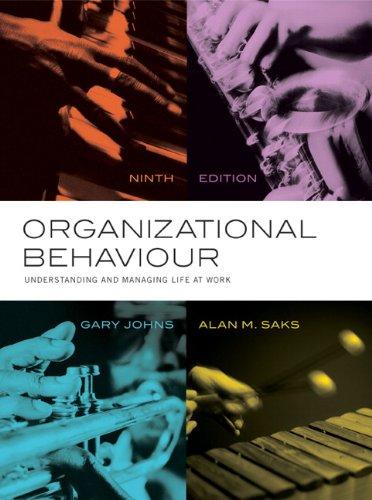Question
1. Describe the motivation process according to expectancy theory. Be sure to identify and describe the three core constructs and how they relate. Feel free
1. Describe the motivation process according to expectancy theory. Be sure to identify and describe the three core constructs and how they relate. Feel free also to draw a diagram if that would help in your explanations. Next, after explaining the theory in general, explain how incentive pay as a compensation strategy can act as a motivator within the framework of expectancy theory. Finally, explain how a manager’s decision to award incentive pay based on an individual team member’s performance versus overall team performance could influence an individual’s motivation through the framework of expectancy theory.
2. According to job characteristic theory (Hackman & Oldham, 1974; 1980), there are five characteristics of jobs that ultimately promote “satisfaction with the work itself.” Identify and define/describe these five characteristics. Then, describe “growth need strength” and explain how this construct may influence the relationship between the five characteristics and employees’ satisfaction with the work itself.
3. What is an individual’s personality? Identify and describe each component of the “Big Five” personality taxonomy. Which component is the most desirable for an employee to possess (in general) and why? Which component is the least desirable for an employee to possess (in general) and why? Finally, for the remaining three components, identify a particular type of team where you think each would likely be a beneficial personality trait for a team member to possess and why you believe this is the case.
4. Describe both distributive and procedural organizational justice and how they differ. How may one’s level of collectivism influence his/her interpretation of a situation as reflecting distributive justice? How may one’s level of power distance influence his/her interpretation of a situation as reflecting procedural justice? Finally, which of the four primary decision making styles (see the slides on leadership styles/models) do you believe would lead to a manager’s decision most often being interpreted as distributively and procedurally just by an employee?
5. In his research on the “universalism” of leadership, Bass identified five categorizations of leadership styles that could be universally applied across cultural contexts. Identify and describe these five leadership styles. Next, identify which of the five is considered the best and which is considered the worst. Finally, for those three not considered the best or the worst, which higher- order leadership classification can be used to characterize each?
6. First, identify and describe the four team classifications using a “level of responsibility in setting procedures and developing objectives” classification strategy. Which of these team types (feel free to specify one type or more than one type) do you believe may promote team members’ developing high levels of intrinsic motivation for their core team tasks and why? Second, identify and describe the four team classifications using a “nature of team interdependence” classification strategy. For which of these team types do you believe complementary fit between team members may be most beneficial and why? Additionally, for which of these team types do you believe supplementary fit between team members may be most beneficial and why?
7. Define socialization and identify at least one goal of the socialization process. Next, identify and describe the three stages of socialization. Then,for the first socialization stage only, identify and describe two useful organizational practices that may facilitate this stage of the socialization process. Finally, do you believe the socialization process may be more important in organizations that have a mechanistic structure or organic structure?
Please explain your reasoning.
8. First, define and describe the three types of organizational commitment according to Meyer and Allen (1991). Second, drawing on either self-determination theory or social exchange theory, briefly describe how individuals may develop a sense of organizational commitment. Finally, identify the four proximal influences on organizational commitment according to Meyer (2009) (see the slides/your notes).
Step by Step Solution
3.38 Rating (160 Votes )
There are 3 Steps involved in it
Step: 1
Question 1 Expectancy Theory and Incentive Pay Expectancy theory is a motivational theory that proposes individuals are motivated to act in certain ways based on their beliefs about the outcome of the...
Get Instant Access to Expert-Tailored Solutions
See step-by-step solutions with expert insights and AI powered tools for academic success
Step: 2

Step: 3

Ace Your Homework with AI
Get the answers you need in no time with our AI-driven, step-by-step assistance
Get Started


